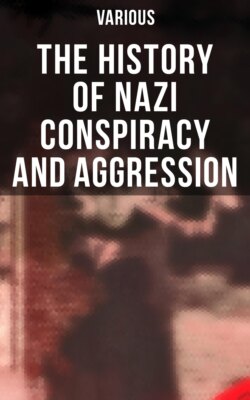Читать книгу The History of Nazi Conspiracy and Aggression - Various - Страница 115
На сайте Литреса книга снята с продажи.
ОглавлениеAlfred Rosenberg—The delegate to the Fuehrer for Ideological Training and Education of the Party. (Der Beauftragte des Fuehrer’s fuer die Ueberwachung der gesammten geistigen und weltanschaulichen Schulung und Erziehung der NSDAP).
Hans Frank—At one time head of the Legal Office of the party (Reichsleiter des Reichsrechtsamtes).
Baldur von Schirach—Leader of Youth Education (Leiter fuer die Jugenderziehung).
and the late
Robert Ley—Leader of the Party Organization (Reichsorganisationsleiter der NSDAP) and Leader of the German Labor Front (Leiter der Deutschen Arbeitsfront).
The next categories to be considered are the Hoheitstraeger, the “bearers of sovereignty.” To them was assigned political sovereignty over specially designated subdivisions of the state of which they were the appointed leaders. The Hoheitstraeger may be said to represent the vertical organization of the party. These leaders included all:
a. Gauleiter, of which there were 42 within the Reich in 1945. A Gauleiter was the political leader of the largest subdivision of the State. He was charged by the Fuehrer with political, cultural, and economic control over the life of the people, which he was to coordinate with the National Socialist ideology. A number of the defendants before the bar of the Tribunal were former Gauleiter of the NSDAP. Among them are Julius Streicher (Franconia) whose seat was in Nurnberg, Baldur von Schirach (Vienna), and Fritz Sauckel (Thuringia).
b. Kreisleiter, the political leaders of the largest subdivision of a Gau.
c. Ortsgruppenleiter, the political leaders of the largest subdivision of a Kreis consisting of several towns or villages, or of a part of a larger city, and including from 1500 to 3000 households.
d. Zellenleiter, the political leaders of a group of from 4 to 8 city blocks or of a corresponding grouping of households in the country.
e. Blockleiter, the political leaders of from 40 to 60 households.
Each of these Hoheitstraeger, or “bearers of sovereignty,” was directly responsible to the next highest leader in the Nazi hierarchy. The Gauleiter was directly subordinate to the Fuehrer himself, the Kreisleiter was directly subordinate to the Gauleiter, the Ortsgruppenleiter to the Kreisleiter, and so on. The Fuehrer himself appointed all Gauleiter and Kreisleiter, all Reichsleiter, and all other political leaders within the Party Directorate (Reichsleitung) down to the grade of Gauamtsleiter, the head of a subdivision of the party organization within a Gau.
The Hoheitstraeger and Reichsleitung together constituted the all-powerful group of leaders by means of which the Nazi party reached into the lives of the people, consolidated its control over them, and compelled them to conform to the National Socialist pattern. For this purpose, broad powers were given them, including the right to call upon all party machinery to effectuate their plans. They could requisition the services of the SA and of the SS, as well as of the HJ and the NSKK.
The controlled party organizations (Gliederungen der NSDAP) actually constituted the party itself, and substantially the entire party membership was contained within these organizations, viz.:
SA—NS Storm Troops (Sturmabteilungen).
SS—NS Elite Corps (Schutzstaffeln).
NSKK—NS Motor Corps (Kraftfahrkorps).
HJ—Hitler Youth (Hitlerjugend).
NS Women’s Organization (Frauenschaft).
NS German Students’ Bund (Deutscher Studentenbund).
NS University Teachers’ Bund (Deutscher Dozentenbund).
There were additional affiliated organizations (Angeschlossene Verbaende der NSDAP). Among these were included the following:
DAF—German Labor Front (Deutsche Arbeitsfront).
NS Public Welfare Organization (Volkswohlfahrt).
NS War Victims’ Organization (Kriegsopferversorgung).
NS Bund for German Technology (Bund Deutscher Technik).
German Civil Service (Reichsbund der Deutschen Beamten).
NS Physicians’ Bund (Deutscher Aerztebund).
NS Teachers’ Bund (Lehrerbund).
NS League of Legal Officials (Rechtswahrerbund).
A third group of organizations was officially known as supervised organizations (Betreute Organisationen der NSDAP). These included the following:
German Women’s Work (Deutsches Frauenwerk).
German Students’ Society (Deutsche Studentenschaft).
NS Bund of Former German Students (Altherrenbund der Deutschen Studenten).
Reich League “German Family” (Reichsbund Deutsche Familie).
German Communal Congress (Deutscher Gemeindetag).
NS Bund for Physical Exercise (Reichsbund fuer Leibesuebungen).
According to the official party designations, there was a fourth classification known as Weitere Nationalsozialistische Organisationen, and in this category the following organizations appeared:
RAD—Reich Labor Service (Reichsarbeitsdienst), at one time subordinate to the Reich Labor leader (Reichsarbeitsfuehrer).
NSFK—NS Flying Corps (NS-Fliegerkorps), which was subordinate to the Reich Minister for Aviation.
